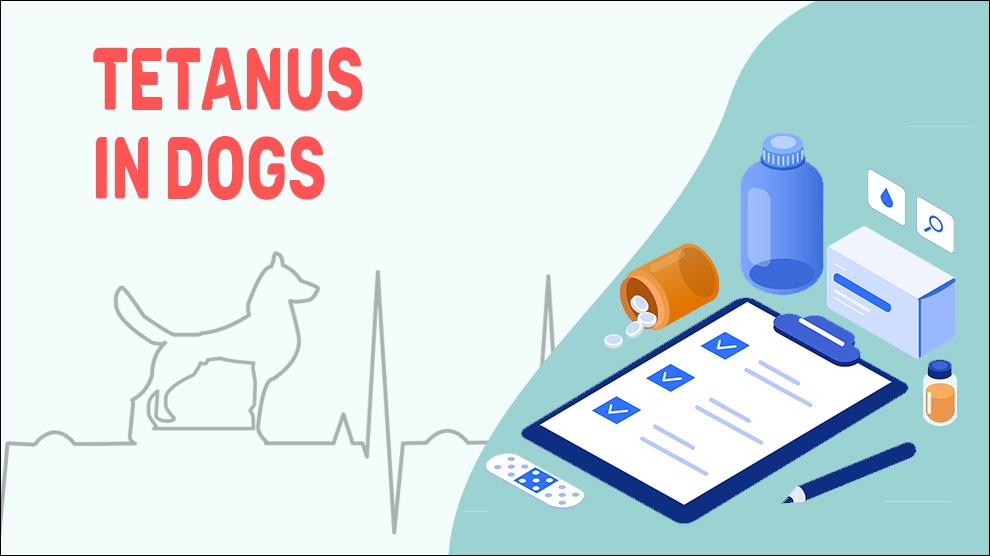What Is Tetanus In Dogs?
Tetanus is a relatively uncommon but potentially life-threatening disease in dogs. The dog's muscles overreact to an external stimulus such as toxins, making them stiffen with muscle spasms and rigid paralysis of the respiratory muscles. Also known as "lockjaw," This is due to the infection with the toxin secreted by an anaerobic bacterium known as Clostridium tetani.
When C. tetani spores infiltrate the wound in the dog's body (or humans, altogether), it secretes the neurotoxin ‘tetanospasmin’. This toxin's target area is the nerves in that region, and they can migrate up into the spinal cord /brain where it interferes with the release of inhibitory neurotransmitters- glycine and GABA.
These bacteria spores are ubiquitous in the environment all over the world. They can survive for months or even years and are very resistant to degradation. Soil cultivation, fertilization, and increased moisture make it easier for these organisms to populate. These pathogens are also available in the feces of many animals - including dogs. Symptoms of infection are developed within 5-10 days of infection, but overall range from 3-20 days. Infections can be rapid when the wound is in close proximity to the central nervous system (CNS) if pathogens are present in high numbers or in an environment with less oxygen.
In dogs, generalized (whole body form) tetanus is less common than localized tetanus. The limb nearest to the original wound will tremor or becomes rigid. Localized tetanus is easier to treat than the generalized form; but, the localized form can spread and upgrade to the generalized form. In generalized tetanus, initial symptoms are concerned with the eyes and can easily be misdiagnosed as eye disease.
Symptoms Of Tetanus In Dogs
- Elevated Third eyelids
- Erect ears
- Swelling of the face
- Wrinkled forehead due to muscle spasms
- Risus sardonicus- sinister smile due to held back lips
- Stiffening of the neck and jaw
- Muscle spasms
- Standing with straight, rigid legs
- Stiffening of the tail
- Pain when touched
- Drooling
- Fever
- Difficulty eating and drinking
- Difficulty breathing
- Constipation
- Dehydration
Treatment Options For Tetanus In Dogs
- Antitoxin (tetanus immune globulin)
- Antibiotics: Metronidazole (Flagyl), Amoxicillin/Clavulanate (Clavamox), Gentamicin, Chloramphenicol, Sulfamethoxole, Tetracycline, etc
- Anticonvulsants: Benzodiazepine family, Levetiracetam, valproic acid, zonisamide felbamate and gabapentin
- Muscle relaxants: Methocarbamol (Robinax, Robaxin, Robaximo)
Home Remedies For Tetanus In Dogs
- Home-cooked diet, with wholesome, nutritious foods as an substitute to commercial diets
- An inflatable/ Elizabethan collar works best for chewy or rough dogs
- Use anti microbial wipes/pet-friendly cleansers and keep the dog clean and dry
- Use creams/gels to ease irritation &
How To Prevent Tetanus In Dogs?
- The best way of tetanus prevention is to address scratches, cuts, or wounds in the dogs immediately.
- Regularly use medicated wipes containing a skin disinfectant to clean the skin of the dogs when you see any cuts or wounds.
- With clean paper napkins (or cotton washcloths), the dog skin folds should be cleaned at least twice weekly. You can also use veterinary formula shampoo (e.g. vetMD medicated shampoo), spray, or skin cleanser.
Affected Dog Breeds Of Tetanus
Large Dog Breeds, Labrador Retriever, Golden Retriever
- There is no breed predisposition.
- However, this is more common in dogs that are more prone to wounds such as outdoor dogs, hunting, and hound breeds.
Causes And Prognosis For Tetanus In Dogs
1. Causes:
- Outdoor dogs, hunting, and hound breeds
- Large breeds (Labradors, German shepherd)
2. Mortality: With prompt treatment, the Survival rate of dogs with tetanus is 90%. In dogs, it may take up to a month for complete recovery. If left untreated, it is really fatal for dogs.
3. Diagnosis:
- Complete blood count, chemistry panel
- Specialized blood tests (IgE blood tests)
- Creatine phosphokinase (CPK) test
- Intradermal testing (IDT)
- Electromyography
4. Prognosis:
The prognosis for recovery of dogs with tetanus depends on the extent of infection. For mild tetanus, dogs may recover without any treatment, but severely affected dogs are less likely to survive without rigorous treatment. Simply the earlier the diagnosis, the better the prognosis. Typically, after a week of initiating therapy improvements are seen, but complete recovery may take a month.
When To See A Vet For Tetanus In Dogs?
Contact your vet right away, if you notice any of the following:
- Swelling of the face
- Wrinkled forehead due to muscle spasms
- Risus sardonicus- sinister smile due to held back lips
- Stiffening of the neck and jaw
- Muscle spasms
Food Suggestions For Tetanus In Dogs
- Vitamin-rich fruits and veggies: Legumes, snap peas, green beans, carrots, cauliflower, broccoli, cabbage, tomatoes, citrus fruits, Blueberries, strawberries, cherries, etc
- Fiber-filled veggies: Sweet potato, acorn squash, pumpkin, etc
- Fats: Salmon, herring, mackerel, lake trout, tuna, and sardines
- Complex Carbs: Brown Rice, Oatmeal, Whole Grains, Sweet Potatoes, etc
- Antioxidant-packed fruits: Blueberries, cherries, cantaloupe, peeled apple, etc
Conclusion
Early detection and appropriate treatment offer the most favorable prognosis. The recuperation period for tetanus is different for every dog. Based on the treatment protocol or medication schedule, you’ll get a good idea of when to expect a complete recovery.

















